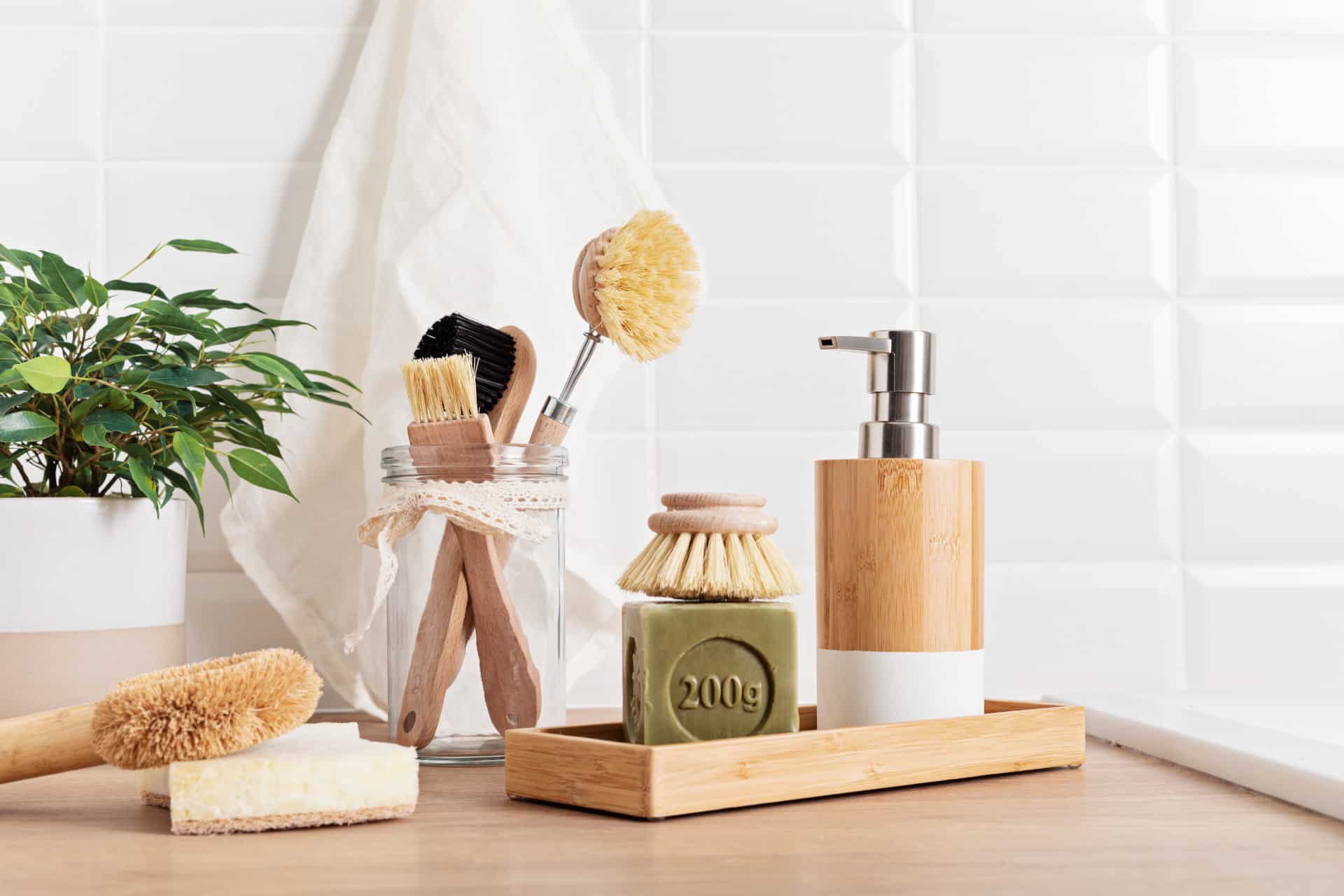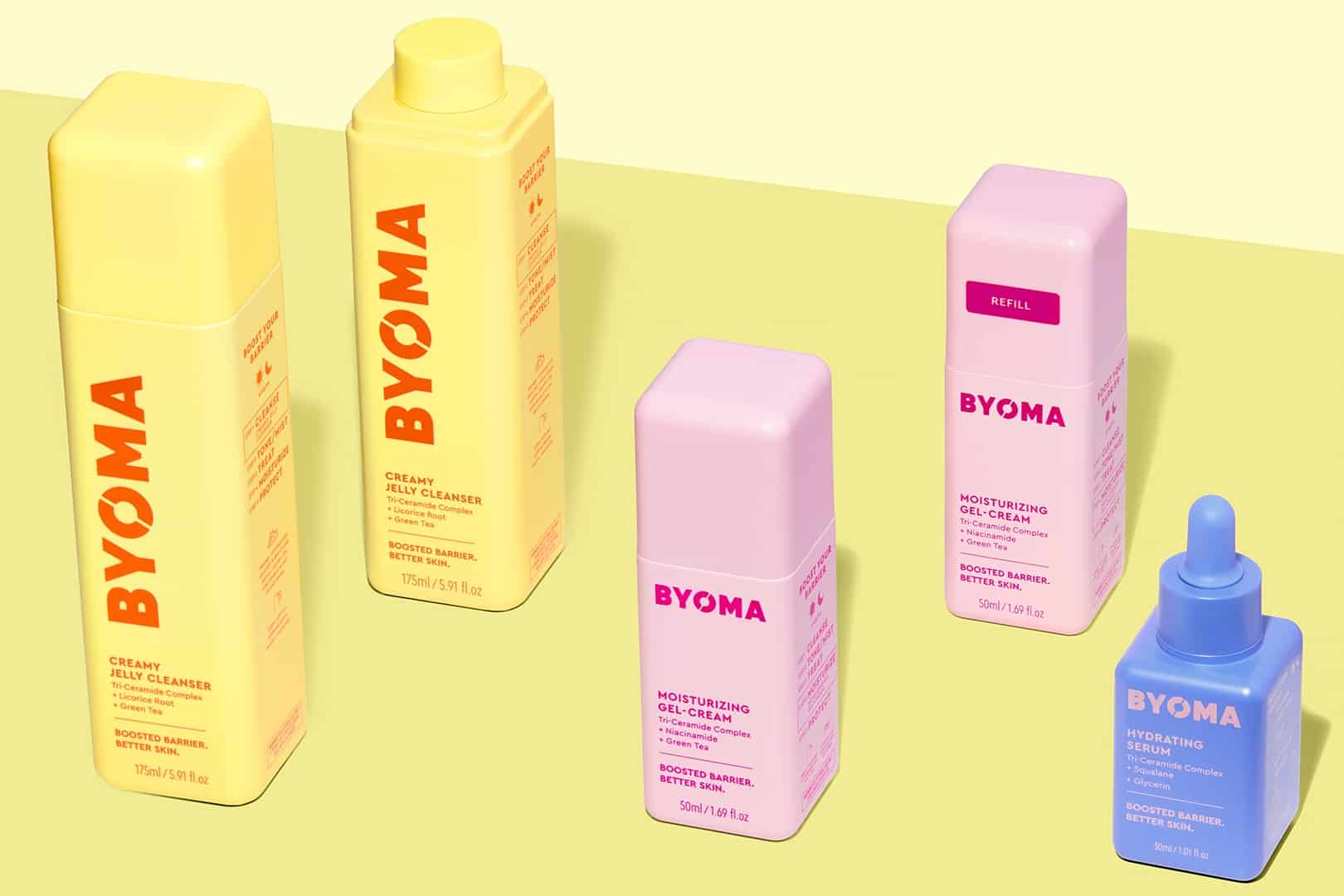The Best Eco-Friendly & Biodegradable Cat Litters Analyzed
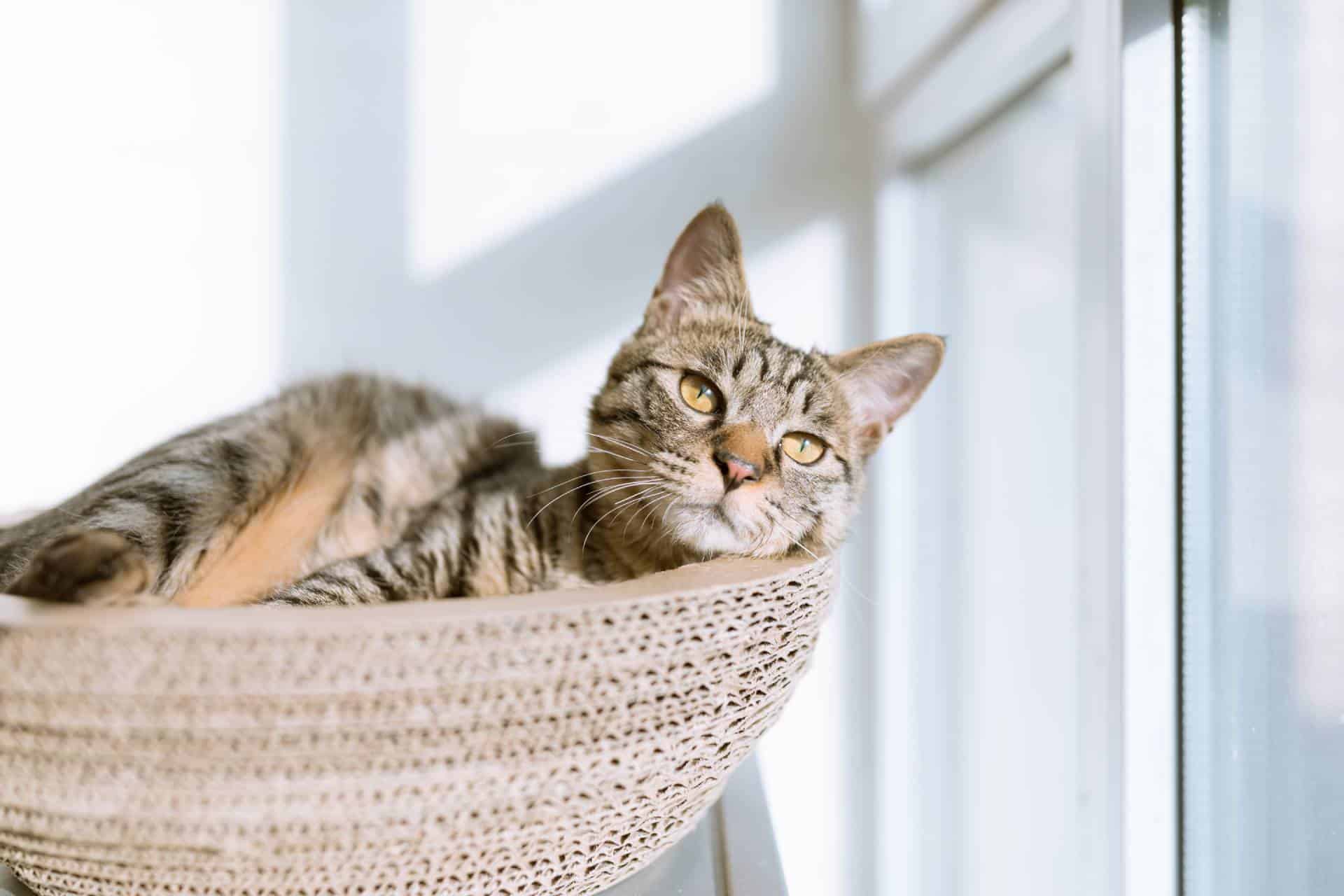
When making the change to a more sustainable lifestyle, your cat’s litter box is one of the easiest places to start.
Not only is traditional clay cat litter terrible for the environment, but it’s also not great for your kitty’s health. Making the switch to an eco-friendly cat litter is a win-win for everyone involved—kitties and humans alike.
There are many different options on the market for eco-friendly cat litters, and it can be tough to decide which one is right for you and your feline friend. We’ve done the research for you and put together a list of the best eco-friendly cat litters on the market.
Want to jump directly to our recommendations? Click here.
The Problem With Traditional Clay Cat Litter
The vast majority of cat litter on the market is made from clay. It’s cheap, effective, and easy to find. Clay cat litter is made from bentonite clay, a type of absorbent clay that can absorb up to 40 times its weight in liquid. It’s also highly effective at absorbing urine and controlling odor.
There’s a major problem with clay cat litter, however.
According to statistics from the U.S. Geological Survey, in 2012 2.4 tons of clay were used to make cat litter. To put this into perspective, this is enough to fill 180,000 dump trucks.
What’s more, bentonite clay is a non-renewable resource. Once it’s mined, it can’t be replaced. And the process of mining bentonite clay is incredibly damaging to the environment.
The mined clay is short-lived, too. Since it can’t be disposed of down the toilet, it all ends up in the dump. This is incredibly wasteful, and modern cat litter is riddled with chemicals like fragrance, anti-clumping sprays, and PTFE (Teflon).
Potential Health Risks of Traditional Clay Cat Litter
We found a 2016 study that concluded the following:
Bentonite itself is probably not more toxic than any other particulate not otherwise regulated and is not classified as a carcinogen by any regulatory or advisory body, but some bentonite may contain variable amounts of respirable crystalline silica, a recognized human carcinogen.
Bentonite toxicology and epidemiology – a review
There are numerous warnings online about the inhalation of crystalline silica. The Occupational Safety and Health Administration (OSHA)—an official government entity and part of the Department of Labor—has a page on the dangers of inhaling silica dust. The Centers for Disease Control and Prevention (CDC) have a similar page discussing how the inhalation of silica dust can lead to a disease called silicosis.
The fact that clay cat litter can be contaminated with dangerous crystalline silica dust is alarming. For this simple fact alone, we believe that clay cat litter is unsafe and should be avoided.
Another study from 2020 tested the effects of bentonite nanoparticles on lab rats:
During long-term exposure and at higher concentrations, BNPs (betonite nanoparticles) increase the level of MDA as a result of increased oxidative stress. Histological results showed that the absorption of BNPs causes different alternations including lung inflammation, macrophage accumulation, granuloma formation, acute neutrophilic reaction, and pulmonary fibrosis in exposed groups compared to the control group. By increasing the concentration and exposure time of BNPs, more severe damages to lung tissues can be observed. Given the toxicity of these nanomaterials to health, further studies are suggested to predict these nanoparticles on other tissues and body fluids at other concentrations and exposure times.
Effects of bentonite nanoparticles inhalation on lung tissue and blood antioxidant indices in a rat model
This further proves that clay cat litter—and its nanoparticles—can be dangerous to your health.
Even cat litter dubbed “dust-free” will inevitably release some clay particulates into the air when your cat uses it. And these particles can be inhaled, leading to various health problems.
We believe the risks of using clay cat litter far outweigh any benefits. For this reason, we recommend avoiding clay cat litter altogether and opting for a safer, more sustainable option.
Crystal Cat Litter is No Better Than Clay
Crystal cat litter is a popular newer type made from absorbent silica gel. It’s popular because it promises to be virtually dust-free and very effective at absorbing urine and controlling odor.
We did a deep analysis of a popular brand of silica gel litter—Pretty Litter—and found some pretty shocking results. In our research, we found that there are two types of silica: crystalline and amorphous silica.
Confusingly, cat litter made from silica gel is generally made from amorphous (not crystalline) silica. We were unable to find any cat litters claiming to be made from dangerous crystalline silica
However, crystal cat litter isn’t without its own potential risks.
- In fact, a 2002 study published in the European Respiratory Journal links silica cat litter as a possible trigger for sarcoidosis—an inflammatory lung disease.
- We found another study online which concluded that silica gel particles could be dangerous to your cat.
In our analysis of Pretty Litter, we found several anecdotal reports online of negative health impacts of this crystal litter, including a user video showing incredible amounts of dust created by handling it in the litter box.
For this reason, we also do not recommend using crystal cat litter like Pretty Litter.
Safer Alternatives: The Different Types of Eco-Friendly Cat Litters
Now that we know that clay and silica-based litters should be avoided, what are the best eco-friendly cat litters?
Paper Cat Litter
Paper cat litter is made from recycled paper products, usually newspaper or cardboard. Like wood litters, they’re absorbent and have good odor control properties. Paper litters are also biodegradable, making them a good eco-friendly option.
One downside of paper litter is that it can be tracked around the house more easily than other types of litter. They’re also not as good at clumping as clay or silica-based litters so they may require more frequent changing.
Still, paper litters are a good eco-friendly option, and we recommend them if you’re looking for a more sustainable option.
Wood Cat Litter
Wood cat litter comes in the form of small pellets made from wood—most commonly pine and cedar. It’s absorbent, dust-free, and lasts long. It’s also non-tracking and fairly absorbent, making it a good choice for those with messy cats.
Wood cat litter doesn’t clump like clay-based litter. When your cat uses the litter box, the wet pellets will sink to the bottom while the dry pellets float to the top. This makes scooping out the waste a bit more difficult, as you have to sift through all the pellets to find the soiled ones.
Used wood cat litter can be composted or disposed of in the trash.
Wheat-Based Cat Litter
Wheat-based cat litter is made from wheat straw, a byproduct of the wheat harvest. It’s natural, absorbent, and doesn’t track as much as clay-based litter. It has a similar consistency to traditional clay-based litter, so it shouldn’t be too difficult for your cat to adjust to.
Wheat-based cat litter offers other benefits to kitties and their owners, too. This litter is safe for cats to eat, which is a great benefit for those that accidentally ingest some of the litter when cleaning themselves.
This eco-friendly litter is also suitable for cats prone to infection and those recovering from surgery. The wheat straw contains lignin—an antibacterial and antifungal compound.
There are a few downsides to wheat-based cat litter, however. Some cat owners find wheat-based litter to be more easily tracked through the house. Some kitty owners also find that when mixed with urine, wheat-based litter can also create a quite unpleasant aroma.
Finally, some cats can be allergic to wheat, so it’s essential to watch for adverse reactions if you switch to this type of litter.
Walnut-Based Cat Litter
Walnut cat litter is made from walnut shells, making it a great eco-friendly and renewable alternative to clay-based cat litter.
Walnut cat litter clumps, but not quite as well as traditional clay cat litter you might be used to. This means you must take more care to handle the clumps to ensure they don’t break up while disposing of them.
There can be some tracking with walnut cat litter—about the same that you can expect if you’re used to clumping clay cat litter.
Corn-Based Cat Litter
Corn-based cat litter is made from—you guessed it—corn. Made from either corn kernels or the cobs themselves, this litter is 99% dust free.
Some people have concerns about the use of GMO corn in the litter, although at Better Goods, we don’t believe that this should be a concern when used in litter. The amount of contact your cat has with the litter is very minimal.
Corn-based cat litter is biodegradable and can be composted. It’s also relatively absorbent and forms clumps when wet, making it easy to scoop.
Challenges With Switching Cats to Eco-Friendly Litter
The first thing you need to know is that not all cats will take kindly to a change in their litter. In fact, some may flat-out refuse to use it. Cats prefer to keep to the substrate they’re used to in their litter boxes. When given the choice between their old, comfortable litter and a new, unfamiliar type of litter, they will usually go with the former. Cats can be prissy creatures.
You can do a few things to make the transition to an eco-friendly cat litter easier on your kitty. First, start by mixing the new litter with their old, familiar litter. Slowly increase the ratio of new to old litter until you’re using only the eco-friendly variety. This will give your cat time to adjust to the new substrate and should make the transition smoother.
You Should Never Flush Cat Litter—Here’s Why
Many eco-friendly cat litter brands advertise their product as being flushable. While this sounds convenient, you should never flush cat litter down the toilet. Please, just don’t do it.
Flushing cat litter can cause all sorts of problems in your plumbing. The clay and other particles in cat litter can clump together and create blockages in your pipes. This can lead to backups and overflows, which are a huge pain (and a big mess) to deal with.
Moreover, flushing cat litter can also introduce harmful bacteria into our water systems. While our sewage treatment plants do a good job of filtering out contaminants, they’re not perfect. Some bacteria can slip through and end up in our lakes and rivers. This pollutes our waterways and can be dangerous to the plants, animals, and humans that rely on them. The United States Environmental Protection Agency (EPA) classifies pet waste as a pollutant.
So, even though it may be tempting to flush your cat’s waste away, it’s best to avoid doing so. Stick to the old-fashioned method of scooping it into a bag and throwing it in the trash. Your plumbing (and the environment) will thank you.
How To Properly Dispose of Cat Litter
When you’ve scooped and bagged your cat’s waste, the next step is to dispose of it properly. We’ve established that it’s unsafe to flush it down the toilet—even if the manufacturer says it’s safe.
So, what’s the best way to get rid of it?
The answer is simple: throw it in the trash. Just be sure to use a heavy-duty garbage bag to avoid any messes. And if you’re using clumping litter, be sure to double-bag it. This will help prevent any accidents should the bag tear open.
If you have a compost bin, you can add used cat litter. However, you should only do this if the litter is made from natural materials like wood or corn. Do not add clumping clay litter to your compost pile as the clay will not break down and could contaminate your other compostables.
The exact method to compost cat litter is outside this guide’s scope, but you can find more information online if you’re interested in going this route.
If You Compost Your Litter, Don’t Use It Near Edible Gardens
Cat feces can harbor many harmful bacteria, including E. coli and salmonella. These bacteria can contaminate fruits and vegetables, potentially making people sick. For this reason, it’s important to keep used cat litter away from any edible gardens you may have.
Best Eco-Friendly Cat Litter Brands
#1. World’s Best Cat Litter (Our Corn-Based Litter Recommendation)

| Price | $17.45 ($1.16 / lb) |
| Amount per bag | 15 lbs / 6.8 kgs |
| Made from | Corn |
| Scents | Unscented, Blossom, Lavender |
| Packaging material | #7 BPA-free PET/PE plastic |
| Variations | Original Unscented, Multiple Cat (scented and unscented), Low Tracking & Dust Control, Zero Mess, Picky Cat |
| Where to buy | Chewy / Amazon / Petco |
World’s Best Cat Litter is made from whole-kernel corn, making it an eco-friendly cat litter made from a sustainable resource.
Some people don’t like the natural smell of this litter, which some describe as smelling like a “farm”. However, this is a cat litter box we’re talking about, so you can’t exactly expect it to smell like a flower garden.
This cat litter comes in both scented and unscented versions. We recommend the unscented version—not only does it use chemical fragrance, but we found multiple online reports of people saying the scent combines with the cat urine stink to create a quite unpleasant aroma.
World’s Best Cat Litter is advertised as being flushable, but please don’t flush it. Cat waste is considered a pollutant by the United States Environmental Protection Agency (EPA) and should never be flushed.
#2. Feline Pine (Our Wood-Based Litter Recommendation)
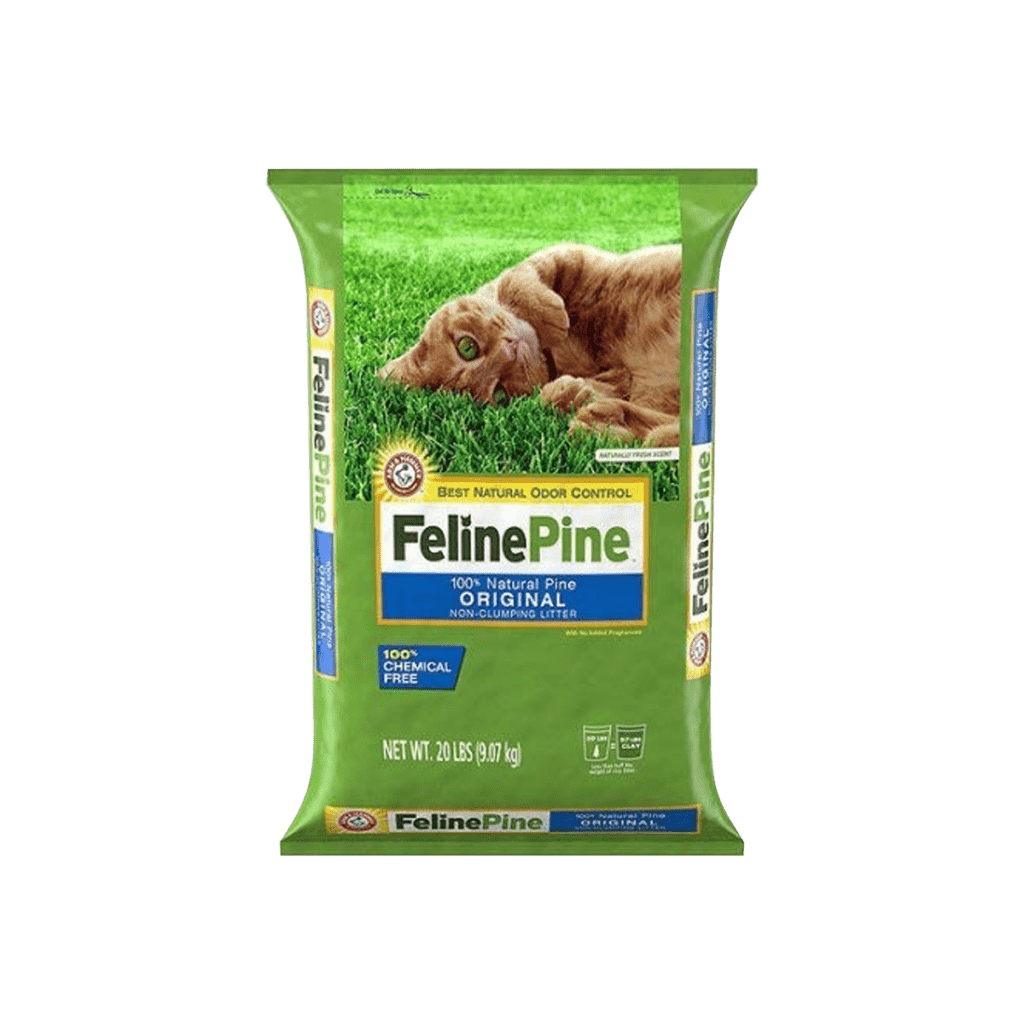
| Price | Clumping: $16.99 ($1.21/lb), Non-Clumping: $14.99 ($0.75/lb) |
| Amount per bag | Clumping: 14 lbs / 6.35 kgs, Non-Clumping: 20 lbs / 9 kgs |
| Made from | Pine (kiln-dried shavings) |
| Scents | Natural Pine scent |
| Packaging material | Unknown |
| Variations | Clumping, Non-Clumping |
| Where to buy | Chewy / Walmart |
Feline Pine is made from reclaimed wood shavings from lumber production and uses no fresh wood in its protection. This makes it an excellent eco-friendly cat litter as it’s made 100% from waste byproduct. It’s essentially just finely ground up pieces of pine, which gives it a natural woodsy smell.
This cat litter can be dusty when pouring, but the dust should be minimal when your kitty uses the box. We found mixed reports on the clumping of this litter: some say that this litter clumps well, and others say that it doesn’t clump well at all.
Nevertheless, this is a good eco-friendly cat litter alternative and our recommendation if you prefer a pine-based litter.
#3. Fresh News Recycled Paper Litter (Our Paper-Based Litter Recommendation)
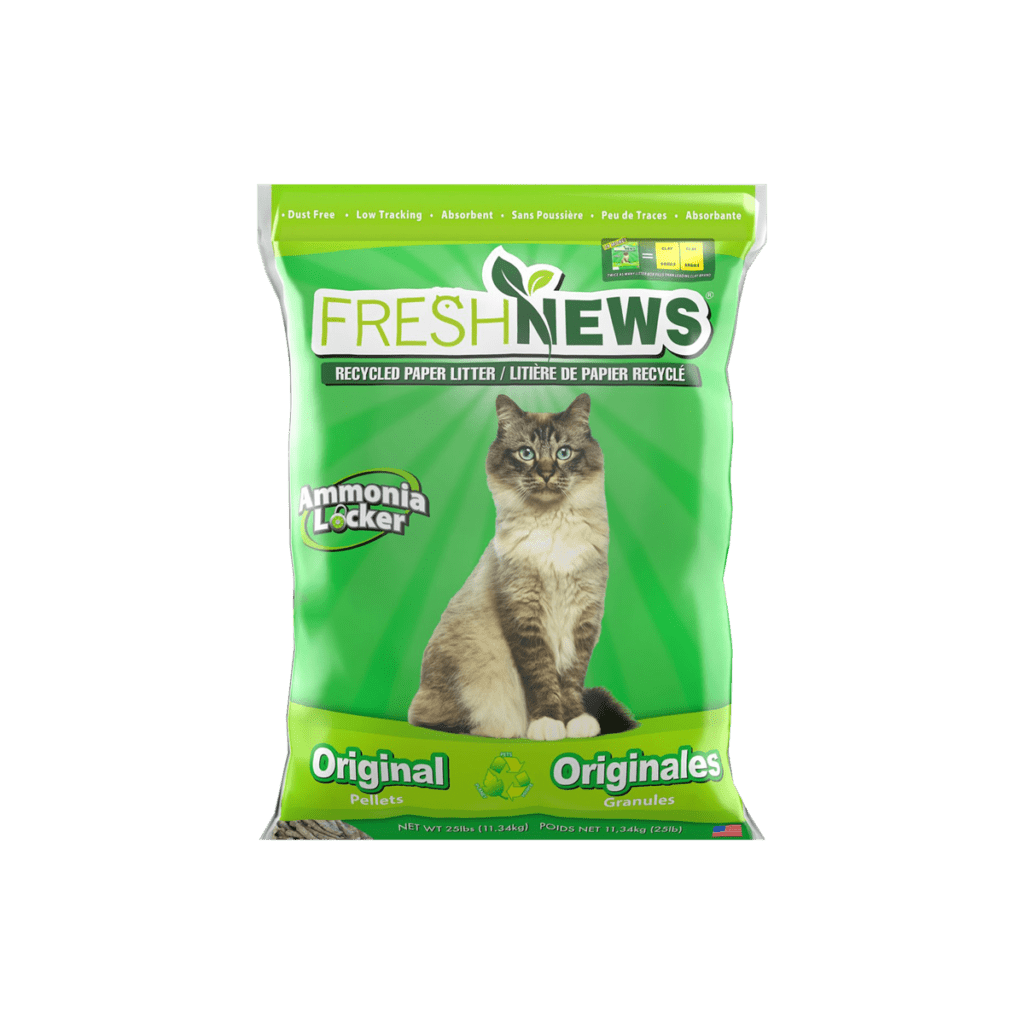
| Price | $12.48 ($1.04/lb) |
| Amount per bag | 12 lbs / 5.44 kgs |
| Made from | Post-consumer paper |
| Scents | Unscented |
| Packaging material | Plastic bag |
| Variations | Original, Multi-Cat |
| Where to buy | Chewy / Amazon |
Fresh News litter is made from 100% post-consumer recycled paper in Michigan. Their non-profit Paper Gator recycling program takes in consumer recyclable paper in the Michigan area and turns it into cat litter. Doesn’t get much more eco-friendly than that.
As the name implies, Fresh News Recycled Paper Litter is made entirely from recycled paper. It’s essentially just finely ground-up newspaper—nothing more, nothing less. The product is in pellet form, and is low tracking.
This eco-friendly cat litter doesn’t do much to mask the urine scent, and this isn’t a clumping cat litter, so cleanup can sometimes be a bit messy. However, this is to be expected when switching to an eco-friendly cat litter.
All in all, this is an excellent eco-friendly litter alternative made from 100% recycled paper.
#4. Naturally Fresh (Our Walnut-Based Recommendation)
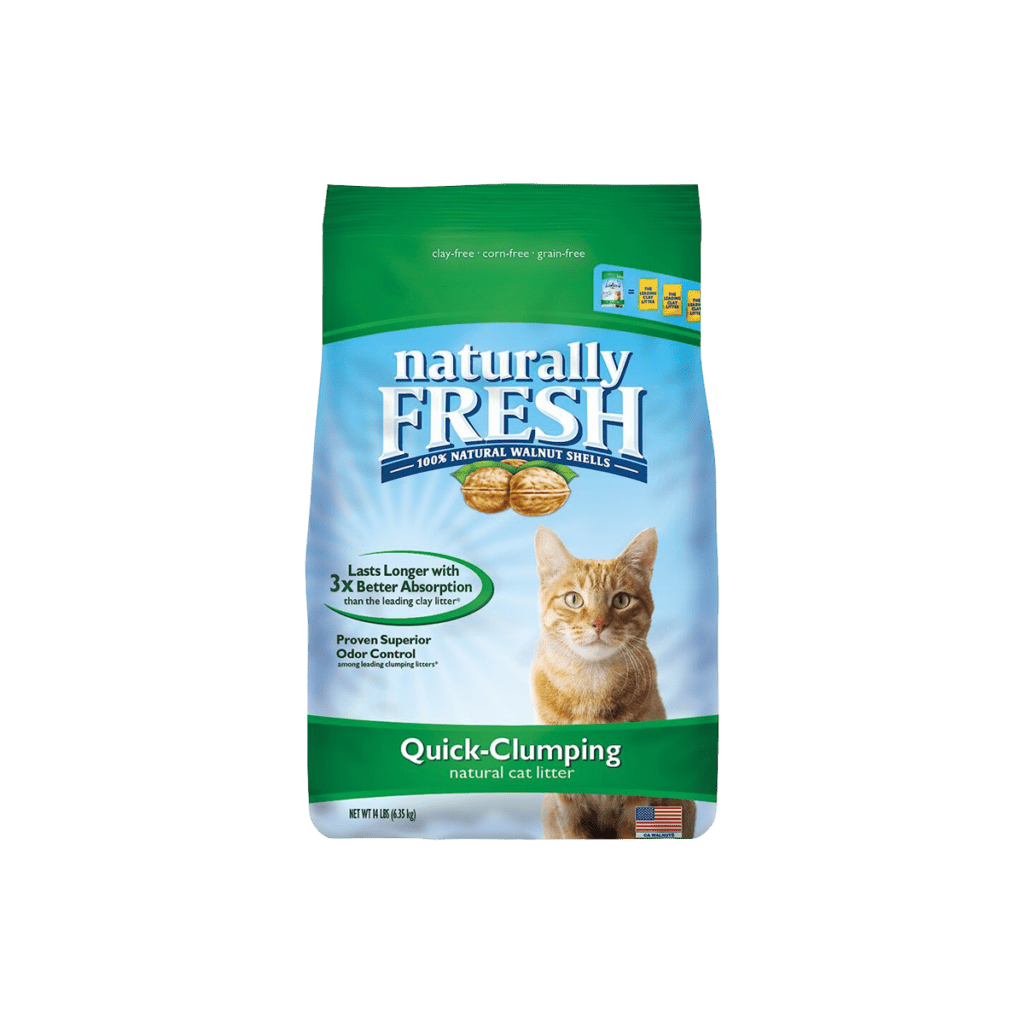
| Price | $18.99 ($1.35/lb) |
| Amount per bag | 14 lbs / 6.35 kgs |
| Made from | Walnut shells |
| Scents | Unscented, Herbal, Alpine Meadow |
| Packaging material | #7 plastic — the brand is currently in the process of redesigning their packaging bag to make it easier to recycle |
| Variations | Multi-Cat, Quick Clumping, Ultra Odor Control, Alpine Meadow, Herbal Attraction, Pellet |
| Where to buy | Chewy / Amazon / Target / Petco |
Made from 100% walnuts, Naturally Fresh is an excellent eco-friendly alternative to conventional clay-based cat litter.
It comes in six variations, and we recommend the unscented versions. We’re currently reaching out to the brand to inquire about what they use for the scent.
The product of Naturally Fresh litter advertises itself as using 42% fewer fossil fuels and 97% mineral resources (because walnut is not a mineral) than clay cat litter. The brand aims to have its packaging be recyclable by 2025 and is produced in 100% solar-run facilities.
This is an excellent eco-friendly litter using 100% of the harvested walnut. The company also is committed to planting thousands of walnut trees every year. Walnut is naturally fibrous, making it super absorbent. The brand claims that you can go at least 30 days between full cleanings, so it lasts a long time, too.
All in all, this is an excellent choice for eco-friendly and non-toxic cat litter.
#5. Swheat Scoop (Our Wheat-Based Recommendation)

| Price | $18.89 ($1.57/lb) |
| Amount per bag | 12 lbs / 5.44 kgs |
| Made from | Wheat and Corn |
| Scents | Unscented, Fresh Linen (cherry blossom, wildflowers) |
| Packaging material | Unknown |
| Variations | Original, Multi-Cat, Fresh Linen, Premium+, Easy Maintenance |
| Where to buy | Chewy / Amazon / Target / Petco |
Made from 100% domestically-grown wheat, this is another eco-friendly alternative to try. It’s not great for odor control, and you may need to change the litter more often to keep the smell down.
You may experience some tracking with this litter, but generally, it shouldn’t be any worse than traditional cat litter can be. It can also be difficult to use, as while it does clump, it doesn’t stay together well and can fall apart when scooped.
While it’s not our top pick, this is a decent option to consider if you’re looking for an eco-friendly alternative to clay or pine cat litter.
So, Which Litter Should I Try?
If you’ve never tried an eco-friendly cat litter, you might be wondering which to try. For the best combination of price, eco-friendliness and quality, we’d recommend World’s Best Cat Litter.
It’s made from whole kernel corn, is relatively inexpensive at $17.45 for a 15 lb bag ($1.16 / lb) and is widely available.
If you’d rather give another type of litter a try, Feline Pine (wood), Yesterday’s News (paper), and Naturally Fresh (walnut) are also great options to try.


